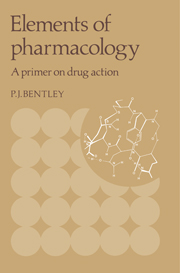Book contents
- Frontmatter
- Contents
- Preface
- 1 Introduction
- 2 Scope of pharmacology
- 3 Where do drugs come from?
- 4 The names of drugs
- 5 Techniques and methods of pharmacology
- 6 Absorption, distribution, and elimination of drugs; pharmacokinetics
- 7 The nature of responses to drugs
- 8 Receptor theory
- 9 Relationship of chemical structure to biological activity
- 10 Roles of the cell membrane in responses to drugs
- 11 Clinical aspects of the actions of drugs
- 12 Conclusion
- References
- Glossary of drugs named in the text
- Index
9 - Relationship of chemical structure to biological activity
Published online by Cambridge University Press: 29 January 2010
- Frontmatter
- Contents
- Preface
- 1 Introduction
- 2 Scope of pharmacology
- 3 Where do drugs come from?
- 4 The names of drugs
- 5 Techniques and methods of pharmacology
- 6 Absorption, distribution, and elimination of drugs; pharmacokinetics
- 7 The nature of responses to drugs
- 8 Receptor theory
- 9 Relationship of chemical structure to biological activity
- 10 Roles of the cell membrane in responses to drugs
- 11 Clinical aspects of the actions of drugs
- 12 Conclusion
- References
- Glossary of drugs named in the text
- Index
Summary
Individual chemical compounds and drugs can elicit particular, and often unique, biological responses. Effects may be confined to the substance involved, or to a group of substances, and be determined by a variety of physicochemical properties of the active compound. The properties of such a reactive molecule that influence its ability to have an effect include its shape, size, electrical charge, distribution of electrons, chemically reactive groups, and intramolecular distances between parts of the molecule that are involved in its interaction with its receptor.
Ideally a complete knowledge and understanding of the importance of such chemical and structural factors, with respect to each type of drug–receptor interaction, could provide a rational basis for the design of drugs with specified properties. The availability of sophisticated computers makes such a prospect more likely (see Gund et al., 1980), but such mathematical predictions or quantitative structure–activity relationships (QSAR) are not yet generally available as a predictive tool. The random screening of compounds for biological activity is time-consuming and expensive, but it is still carried out. However, application of knowledge, limited as it may be, of the relationship of chemical structure to a biological activity can narrow the field of search, though it is still quite empirical. This guided approach usually follows the recognition of some structural correlate to the molecule's biological activity in a particular group of drugs. It is often possible in such situations to modify the chemical structure in order to increase or decrease the potency of the drug, make an antagonist to it, or modify the spectrum of its actions, side effects, and toxicity.
- Type
- Chapter
- Information
- Elements of PharmacologyA Primer on Drug Action, pp. 72 - 78Publisher: Cambridge University PressPrint publication year: 1981



